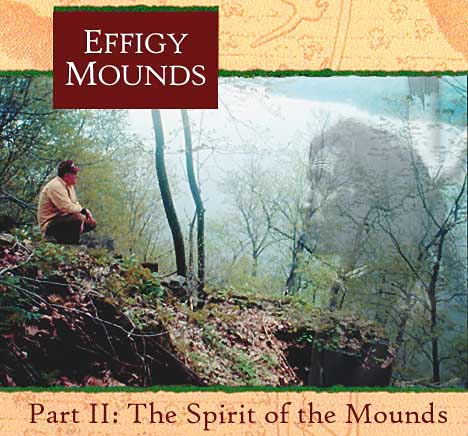
Editorial
|
Press Releases
|
Book Reviews
|
Fragments
Effigy Mounds II
|
Sea Serpents IV
|
Atlantis IV
Register
for our new Hall of Records Newsletter!
Questions? Comments? Suggestions? Advertising? Press Releases?
Contact us!
Effigy Mounds Part I: Iowa's Hidden Mystery
The Search
|
Uncover the Mystery
|
Effigy Links
|
Effigy Books
|
Effigy Audio
 ace to face with the mysteries of the Effigy Mounds, modern man can find it difficult to understand the beliefs and motivations that caused
our ancient forebears to build these enigmatic structures. Yet the ghosts of America's ancient past still call out to the New World
man — an adventurer who is restless, in search of new frontiers to conquer — to confront the spirit of the mounds.
ace to face with the mysteries of the Effigy Mounds, modern man can find it difficult to understand the beliefs and motivations that caused
our ancient forebears to build these enigmatic structures. Yet the ghosts of America's ancient past still call out to the New World
man — an adventurer who is restless, in search of new frontiers to conquer — to confront the spirit of the mounds.

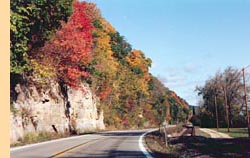 Driving up Route 76, along the west bank of the Upper Mississippi, one can clearly feel modernity gradually slip away, giving place to the ancient and unknown. Despite the comforting concreteness of the expressway, the illusory permanence of everyday life seems to melt away as one passes out of the sprawling Iowa farmlands and plunges deeper and deeper into the vast woodlands of the Upper Mississippi River Valley.
Traveling in the midst of autumn, we slipped down the thin ribbon of road that lay between the river and the stark cliffs that overlook its passage. The setting seemed to speak of old things, of dead things, of ancient memories bound into the layered cliffs overlooking the Father of Waters.
Driving up Route 76, along the west bank of the Upper Mississippi, one can clearly feel modernity gradually slip away, giving place to the ancient and unknown. Despite the comforting concreteness of the expressway, the illusory permanence of everyday life seems to melt away as one passes out of the sprawling Iowa farmlands and plunges deeper and deeper into the vast woodlands of the Upper Mississippi River Valley.
Traveling in the midst of autumn, we slipped down the thin ribbon of road that lay between the river and the stark cliffs that overlook its passage. The setting seemed to speak of old things, of dead things, of ancient memories bound into the layered cliffs overlooking the Father of Waters.
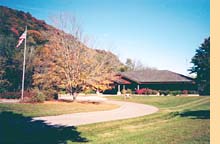
|
|
The Effigy Mounds National Monument Visitor's Center.
|
The scenic views of autumn foliage were spectacular. Distracted by the colors, we nearly missed the entrance to the
Effigy Mounds National Monument (EFMO), which appeared suddenly after a bend in this less-traveled road. Turning into the parking lot, we encountered a low,
unassuming building, which serves as the park's visitor's center. Inside the center was a small museum that was surprisingly good, replete with numerous examples of pottery, arrowheads and spearheads, as well as a variety of related Native American artifacts that gave
us a real sense of how our ancient forebears lived, worked, thought and died centuries ago.
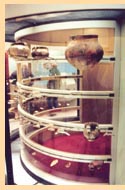
|
|
An exhibit of Native American artifacts on display in the Effigy Mounds National Monument museum including pottery, arrowheads,
spearheads and much more.
|
The museum also features an excellent scale model of the mounds, which gave us a really good understanding of the overall layout of the area.
After the usual video introduction to the park and its features, we set out on the
North Unit
trail. It was a crisp autumn day, with a brisk wind blowing through the trees. Soon after we set out on the trail, we encountered just off to the right of the trail a group of three prominent mounds, known as "Three Mound Group", gently rolling into the landscape. These mounds, believed to be as much as 2,000 years old, apparently hosted numerous artifacts, including a copper breastplate and shells that had originated in the Gulf Coast.
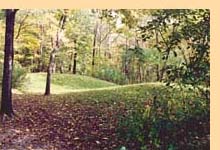
|
|
Two of a set of three conical mounds just a short walk from the Visitor's Center. Archaeologists found several bundle burials and many
artifacts inside these mounds, including a copper breastplate and numerous shells native to America's Gulf Coast, many hundreds of
miles away.
|
This discovery was yet further proof of ancient trade
networks that had at one time been spread out many hundreds, even thousands of miles across the American Midwest, stretching to both oceans
and what is now known as the Gulf of Mexico.
As we saw in
Part I,
The Woodland Period in which these mounds were built was a time of extensive trading all over North America, particularly along the Mississippi, which has served as a major trade route for most of the time that man has occupied the American Midwest.
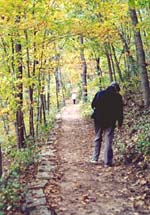
|
|
A natural cathedral of autumn colors awaits the fall traveler.
|
After having taken a few moments to admire the natural beauty of these simple mounds, we began our upward ascent to the clifftops on which the majority of the mounds wait silently. The climb was at first gentle, a pleasant pathway passing cleanly through a natural cathedral of autumn colors. After a short, pleasant walk, however, the path became decidedly more steep, zigzagging up the side of the cliff face. Though somewhat difficult, this upward climb was more challenging than exhausting, but still proved to be the most difficult part of the North Unit trail.
At the crest of the hill, the path flattened out substantially, and the remainder of the trail proved to be very pleasant. After only a brief
walk, we spotted another large mound structure off to the left of this trail. This one, unlike the previous group of mounds, appeared to be long and straight.
|
|

|
|
|
Native plantlife flowers abundantly along the well-defined pathways.
|
|
Despite the damage time and erosion had done to flatten it out, a closer look revealed that this long, thin mound was
punctuated with three wider sections, making it a classic "compound mound". A compound mound is essentially a series of conical mounds created in line with each other, connected together by a thinner linear mound structure. The exact reason as to why the builders had decided to build mounds in this fashion still eludes us, though the most likely reason is to connect several family burials together.
Another possible conclusion that, to my knowledge, has not been explored in the literature, is that the mounds are arranged to reflect
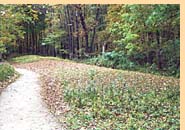
|
|
The North Unit Trail compound mound, one of two mounds of this type in the North Unit. These mounds sometime have burials, but not
always, leading some to believe that they served religious, social and/or political functions.
|
constellations in the night sky. It is an established fact that most all ancient religion had its roots in astronomy and astral
worship, and
Native American religions were no exception.
Perhaps, as we do today, Native Americans memorized the constellations by setting
them down in a more permanent form. Though we today use paper, computer hard drives and CD-ROMs to store our knowledge, the ancient Native Americans used what may have used what they had at hand — dirt and sweat — to form permanent recordings of their constellations.
Sun and astral worship were, in fact, known among the moundbuilders. In 1994, David Lee Smith, tribal historian and cultural preservation officer of the Winnebago Tribe (Ho-Chunk) of Nebraska, visited the mounds and commented on their meaning in their religious teachings:
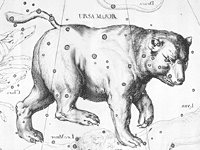
|
|
Ursa Major, "The Great Bear" from Johannes Hevelius' Uranographia (1690). Seeing patterns in the constellations is typical of
all ancient cultures, as the stars were once the objects of worship worldwide. The bear mounds may also be a remembrance of the ancient
concept of the bear in the sky, known to western traditions as Ursa Major. Compound mounds might also serve to imitate
constellations in the sky to which the moundbuilders wished to create permanent memorials, much in the same way we create star maps
today, "connecting the dots" between the stars to identify the constellation. Images adapted from
Chandra X-Ray Observatory Center.
|
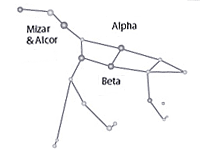
|
Effigy mounds are one of the most sacred religious sites for the Winnebago or Ho-Chunk Tribe. These effigies representing the bear, the
birds, and the snake were constructed by the Winnebago over 1,500 years ago. These mounds are a story and prophecy told in dirt. Winnebago
oral tradition tells us of our migration out of the southeast with other Siouan tribes a long time ago. To preserve this history, holy people began the construction of the Walking Bear Mounds and related mounds. Four times a year, during the summer and winter solstices and the fall
and spring equinoxes, major ceremonies were held on top of the mounds. Only medicine men of the Bear, Thunder, and Snake were allowed to
perform religious ceremonies. They represented the air, the earth, and the water. Sacred fire was brought in by one of the other clan medicine
men, usually the Elk clan.... From the snake or linear mounds, medicine men read the future in the stars and prophecies were told.... The
Winnebago people [also] worshipped the power of the sun, for it represented the all Holy one.1
So, the true identity of the linear mounds, is revealed: they represent snakes. Moreover, the linear mounds, and probably the compound mounds,
were used by the shamans of the Bear,
Thunderbird
and Snake clans to "read the future in the stars" and tell prophecies. Underestimated and
misunderstood, the linear and compound mounds may have actually held the most important roles of all in the religion of the ancient moundbuilders, and they apparently still hold the keys to understanding their mysterious religious beliefs.
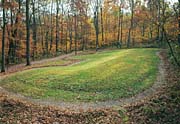
|
|
The "Little Bear" Mound. This mound contained no burials, but had charcoal remains around area where the heart would be, indicating
that it once served a ritual purpose.
|
Continuing on down the path, we soon came upon the "Little Bear Mound". This low mound was nicely outlined with gravel, making its outline
easy to see. This mound was much more impressive than the compound mounds. It was easy to see that, before time and erosion had taken their toll, that this simple monument would have been an impressive sight at night, with the sacred fire burning at its heart.
|
|
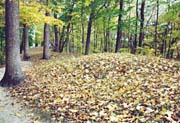
|
|
|
The Fire Point Procession series of mounds. These mounds, that were likely part of a late-night ritual, lead from the Little Bear Mound
to the cliff's edge.
|
|
|
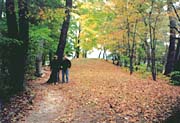
|
|
|
The Fire Point Mound is the largest of the Fire Point Procession, and affords an overlook of the river.
|
|
|
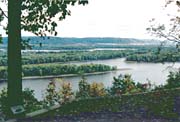
|
|
|
A view of the Mississippi from Fire Point Mound.
|
Just to the right of the Little Bear Mound was a long string of numerous conical mounds stretching all the way to the edge of the cliff.
Called the "Fire Point Procession", this line of 19 mounds was so named because of the presence of charred clay found within the mounds.
Apparently, these mounds also hosted fires at some point, which must have been quite a sight.
This "string of pearls" alight at night would have formed a cathedral of light connecting the Little Bear Mound to the river.
Instead of bypassing the Fire Point Trail, we decided instead to follow the path of those who came before us in this American continent. The trail meandered around the uneven line of mounds, which varied from substantial in size to barely noticeable. The Fire Point Mound at the end was unmistakable, however, and the reason for placing the most prominent mound there was clear. Not unlike our modern cemeteries, this was definitely a tomb with a view, perfectly appropriate for a clan chieftain to be laid to rest. Indeed, even the most exclusive cemeteries would be hard put to beat such an impressive view.
We then took the Fire Trail Loop around back to the main North Unit trail, passing Eagle Rock along the way with its excellent view of the Yellow River. We passed again the compound mounds and the Little Bear Mound and, after a short walk, came upon a truly vast effigy mound —
the "Great Bear Mound". The Great Bear Mound was nearly twice the size of the Little Bear Mound, and was followed by a string of conical and
linear mounds. Also, just off the trail to the right was hidden a conical, linear and a bear effigy mound, which would have been invisible were
it not for creative mowing on the part of the groundskeepers.
|
|
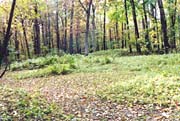
|
|
A secondary bear mound, "off the beaten path", near the Great Bear Mound. Many of the mounds would be nearly invisible if the
groundskeepers did not allow grass and shrubs to grow freely on their surface. For reference, the rear leg is closest to the camera.
|
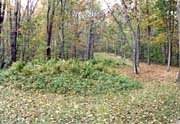
|
|
The beginning of the procession of conical and linear mounds leading north from the Great Bear Mound. These likely were used as part of
religious rituals as were the Fire Point Procession mounds.
|
Each group of mounds seemed like another mini-adventure, an exploration into who and what went before us in history. Following the trail of
conical and linear mounds that spread out north from the Great Bear Mound seemed like we were following a trail of clues in a search to
uncover a mystery. Perhaps the mounds were built by the ancient Native Americans in an attempt to understand the mysterious world in which they lived, an attempt to reconcile the dichotomy of heaven and earth by trying to emulate heaven on earth in the form of mound structures.
If true, this would make the religion of the moundbuilders typical of the period in which they lived. Some believe that the ancient Egyptians arranged
the pyramids of Giza
in such a way as to emulate the constellation of Orion, and aligned internal chambers within the Great Pyramid to aim at certain stars at certain times in history.
Other ancient peoples, such as the Maya, clearly built their pyramids in order to mirror the movements of the sun, moon, stars, and planets. The ancient Britons built Stonehenge as a vast stone calendar in order to track the movements of their gods, the planets, and the ancient
Cahokians
used a "Woodhenge" to determine the days and the seasons of the year to reap, sow, and give thanks to their god, the sun. In retrospect, in
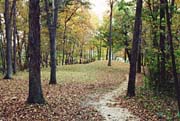
|
|
The Third Scenic View mound group, giving a view of the river and of Hanging Rock. This mound group has conical, linear, and a bear effigy mound.
|
light of the astral religions of the ancient world, it would be unusual for at least some of the mounds to not have some sort of heavenly significance.
We completed the North Unit trail, passing through the Twin Views area, and on to the Third Scenic View, which contained linear, conical and a bear effigy mound. We opted not to go on to Hanging Rock, as the day was moving along, and we wanted to save some time and energy for the South Unit Trail, which promised to have some of the most interesting mounds of all.
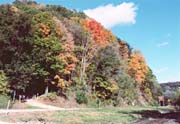
|
|
The entrance to the South Unit Trail, about a half mile south of the North Unit trail. Parking for the South Unit Trail is on the west
side of the street, whereas the trail itself is on the east side.
|
The South Unit trail is actually a short drive from the North Unit trail, about a half mile south. Nestled in a cave of autumn colors, the entrance to the South Unit Trail was somewhat less inviting than that of the North Unit. However, the South Unit, though somewhat obscure, is perhaps the more interesting of the two hikes, and contains some of the most spectacular mound groups in the world.
Parking for the South Unit is on the west side of Route 76, so we had to cross the street, which was a bit disconcerting. The entrance was also
barred by a gate that disallowed vehicle traffic, but access was still allowed on foot, so we proceeded apace around the gate. What followed was a fairly steep and moderately difficult hike that did not level off for nearly half a mile. Along the way, there was an additional bear effigy and linear mound off to the right side of the path that had only been marked on the map with a single dot. Surprised, I realized that more unmarked trails and mounds may await the adventurous explorer with more time to spend than we had that day.
|
|
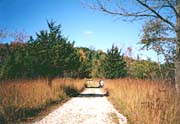
|
|
The Restored Prairie in the midst of the South Unit Trail. The trail forks east to provide easy access to the huge Compound Mound
and two large effigy mounds.
|
Soon after the path had leveled off, we came to a fairly large area of prairie that had been restored by the park service. In the midst of the tall prairie, the path forked, one path heading east towards the huge Compound Mound. We decided to proceed forward and see the Marching Bear Group, as it was the park's premiere attraction, and because we had begun to feel the fatigue of hiking and the bite of a late autumn cold snap. A short walk past the fork, the trail converged with the old military road, which was fairly rough and steep. After another 20-minute hike up the rough military road, the path diverged from the road and lead us directly to the Marching Bear Group, which manifested itself to us at first glance as a grand vista of open trees and lush, green mounds stretching out almost to the limits of our vision.
The Marching Bear Group, according to the Winnebago tribe, who claim descent from the moundbuilders, was created in order to record the journey that their ancestors had made from the southwest in ancient times. These bears may have represented different sub-clans within the bear
tribe, or perhaps a new bear was built to represent each new generation of the bear clan. It may also be that the Marching Bear Group has an astronomical meaning over and above that of the historical and familial one. It may have been created,
for example, as an earthly representation of the Milky Way, which the moundbuilders may have seen as the great place in the sky where the bear spirits walk, the place where their ancestors went when they died. This type of idea was typical of ancient religion but, unfortunately, we can only speculate on the more esoteric meanings of the mounds, as what data we have on the subject is sadly limited.
As a result, the dominant theory behind the purpose of the mounds has been basically that the effigy mounds were metaphorical expressions of the culture's religious beliefs. In 1969, Clark Mallam, the head of nearby Luther College's Anthopology Department made it one of his life goals to unlock the puzzle of the effigy mounds:
To Mallam, the effigy mounds were 'metaphorical expressions of the culture's religious beliefs.' He considered the mounds and rockshelters
sacred places and spent many hours alone at the sites searching for hidden meanings of the petroglyphs and effigy-shaped mounds. Since
effigy mounds contained few artifacts, Mallam believed that more could be learned by studying the pattern of the mounds and the belief systems
of Native Americans than by excavating the mounds. Mallam believed that each complex of effigy mounds, such as the Marching Bear Group, was
constructed by a distinct social group that returned periodically to participate in ceremonies to renew their ties to the earth and insure the
continued cycles of life and the regeneration of plants and animals. The use of animal imagery connected the cultural and natural world of the
social group and maintained a harmony and balance essential for the survival of group members. Mallam's theories blended together the science
of archaeology with Native American religion. He believed the animal-shaped mounds were expressions of the integration of natural, social and
cosmological worlds of the moundbuilders. He suggested 'the effigies appear to be integrated with the earth while at the same time simultaneously emerge from it — the mounds symbolize the cyclical regularity of life itself, ever changing, always the same, constantly
being reborn'.2
So, the general belief to this point, which is probably the correct one, is that the moundbuilders built their mounds as an expression of
solidarity with the natural world they saw around them. Though there may have been additional meanings, as alluded to in the statements made by the Winnebago tribe regarding sun and star worship, we may never know what they were as the moundbuilders have long since disappeared off the world stage as a coherent social entity.
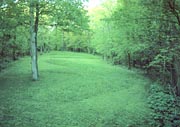
|
|
The two Thunderbird mounds that cap off the Marching Bear Mounds group. All the Thunderbird mounds in EFMO face towards the river,
whereas all but one bear mound face downriver. To this day, their exact meaning remains a mystery.
|
Marveling at the simple beauty of the Marching Bear Group, spread out under the partial canopy of the northeast Iowa forest, we stopped many times to contemplate the meaning of the mounds. One advantage to visiting archaeological sites that the armchair archaeologist misses out on
is the experiential aspect of "being there" in the same millieu that the moundbuilders lived in. One feels the beauty of nature in a very real way, and even the self-satisfied New World man, with his low-interest mortgage and "safe" 401(k) plan, can begin to sense a feeling of his incompleteness when confronted by the down-to-earth lifestyle of the ancient Americans. Perhaps if more people gave more attention to the simpler things in life, to the importance of living naturally, things would be
a lot easier for everyone.
After we reached the end of the bears and spotted the hazy outlines of the Thunderbird effigies, we returned the way we came, taking a quick detour down the east fork to check out at the huge Compound Mound and the nearby effigy mounds. What purpose did these serve? Surely they were not merely ornamentation, but were left as reminders to later generations of the people who once dominated the Midwest. The once mighty and influential Woodland Period cultures have completely disappeared, leaving only scattered tribes whose memories of their golden age are hazy at
best. Was it the coming of the white man, intertribal warfare, or a combination of factors that caused the breakup of the civilization of the Woodland Period? We may never know.
Hopefully the New World man will learn from history and not make the same mistakes that our ancient predecessors on this American continent made that led to their destruction. Sticking to principles, to traditions are what kept the Woodland Period Indians healthy and prosperous for over 700 years. Though theirs was hardly a perfect life, by learning from their simpler lifeways, we may be able to find ways to help our blended culture survive and prosper over the long term. Otherwise, if we do not learn from these our ancient predecessors in the American continent, we may be doomed to repeat their mistakes.
 Walk among the mounds and savor the history of the American Midwest. Effigy Mounds National Monument offers a rare mixture of ancient
history and natural beauty that makes for an excellent day trip. Visit during the summer to see the prairie flowers in full bloom, or
during the fall to see the explosion of colors in the rich forests of northeastern Iowa. Come for the sightseeing, or just for the
exercise. Pets are also allowed, and picnicking facilities are available year-round, so the Monument is also an inexpensive and satisfying
family trip destination.
Walk among the mounds and savor the history of the American Midwest. Effigy Mounds National Monument offers a rare mixture of ancient
history and natural beauty that makes for an excellent day trip. Visit during the summer to see the prairie flowers in full bloom, or
during the fall to see the explosion of colors in the rich forests of northeastern Iowa. Come for the sightseeing, or just for the
exercise. Pets are also allowed, and picnicking facilities are available year-round, so the Monument is also an inexpensive and satisfying
family trip destination.

Effigy Mounds National Park is relatively remote, located in the tiny town of Harper's Ferry, Iowa, three miles north of Marquette,
Iowa and six miles northwest of Prairie du Chien, Wisconsin. Highway 76 is the best method for traveling through this area, as shown
on the maps below:
 Map of northeast Iowa
Map of northeast Iowa
 Map of Effigy Mounds National Monument
Map of Effigy Mounds National Monument
There are also regional airports in La Crosse (70 miles) and Madison (120 miles), WI; and Dubuque (70 miles) and Cedar Rapids (120 miles),
IA. There is no public transportation available.

Effigy Mounds is open daily 8:00 a.m. to 4:30 p.m. with extended hours Memorial Day to Labor Day and weekends in October. The monument is
closed Thanksgiving Day, Christmas Day, and New Year's Day. The Visitor's Center contains interesting and informative displays, a very
good diorama detailing the layout of the mounds, and a nice gift shop with many books and gifts of historical interest. The Museum
in the Visitor's Center is open all year 8:00 a.m. to 4:30 p.m. - extended hours in summer. Phone: 563-873-3491. The Visitor
Center, museum, book sales outlet and auditorium are accessible to wheelchairs. Consult rangers at information desk for access to the
hiking trails.

For more information, contact the
Effigy Mounds National Monument
at 151 HWY 76, Harpers Ferry, IA 52146-7519; phone: 563-873-3491; fax: 563-873-3743; email:
efmo_superintendent@nps.gov.
The best, nearest
lodging
and
dining
is in Prairie du Chien, Wisconsin. Consult the
Prairie du Chien Chamber of Commerce website,
call 1-800-732-1673, or email
info@prairieduchien.org
for more information.




















Effigy Mounds Part I: Iowa's Hidden Mystery
The Search
|
Uncover the Mystery
|
Effigy Links
|
Effigy Books
|
Effigy Audio
Editorial
|
Press Releases
|
Book Reviews
|
Fragments
Effigy Mounds II
|
Sea Serpents IV
|
Atlantis IV
Register
for our new Hall of Records Newsletter!
Questions? Comments? Suggestions? Advertising? Press Releases?
Contact us!

1
Dennis Lezendorf,
Effigy Mounds: A Guide to Effigy Mounds National Monument
(Fort Washington, PA: Eastern National, 2000), 96-97.
2
Dennis Lezendorf,
Effigy Mounds, 93.


 Far Shores: New Investigation Into Ancient Indian Effigy Mounds
Far Shores: New Investigation Into Ancient Indian Effigy Mounds
 University of Iowa Office of the State Archaeologist: Ancient Mounds in Iowa
University of Iowa Office of the State Archaeologist: Ancient Mounds in Iowa
 University of Iowa Office of the State Archaeologist: A Brief Culture History of Iowa
University of Iowa Office of the State Archaeologist: A Brief Culture History of Iowa
 University of Iowa Office of the State Archaeologist: The Oneota Culture
University of Iowa Office of the State Archaeologist: The Oneota Culture
 LAKOTA STAR KNOWLEDGE
LAKOTA STAR KNOWLEDGE
 Chandra X-Ray Observatory: Ursa Major (big bear)
Chandra X-Ray Observatory: Ursa Major (big bear)
 Astronomy Boy: Constellation Portraits: Ursa Major and Canes Venatici
Astronomy Boy: Constellation Portraits: Ursa Major and Canes Venatici
 St. Cloud State: Ursa Major: The Big Dipper or The Great Bear
St. Cloud State: Ursa Major: The Big Dipper or The Great Bear
 The Comparative Archaeology Web: Mounds, Monuments, and the Politics of Power: Dimensions of Effigy Mound Function
The Comparative Archaeology Web: Mounds, Monuments, and the Politics of Power: Dimensions of Effigy Mound Function
 Spirits Made of Earth: The Effigy Mounds - Ho-Chunk Connection Revisited
Spirits Made of Earth: The Effigy Mounds - Ho-Chunk Connection Revisited
 Sorceryn: Earthworks - "Spirits Made of Earth: The Effigy Mounds"
Sorceryn: Earthworks - "Spirits Made of Earth: The Effigy Mounds"
 Beloit College: Woodland Museum: The Woodland Tradition
Beloit College: Woodland Museum: The Woodland Tradition
 Minnesota State University eMuseum: Effigy Mound Building
Minnesota State University eMuseum: Effigy Mound Building
 High Road to Salvage Archaeology: Effigy Mound Culture
High Road to Salvage Archaeology: Effigy Mound Culture
 Mound and Effigy Mound Cultures Discussion Group
Mound and Effigy Mound Cultures Discussion Group
 Society for American Archaeology
Society for American Archaeology
 Mississippian Figurines
Mississippian Figurines
 NativeWeb
NativeWeb

 National Park Service: Effigy Mounds National Monument
National Park Service: Effigy Mounds National Monument
 National Park Service: The Monument
National Park Service: The Monument
 National Park Service: Printable Travel Guide
National Park Service: Printable Travel Guide
 Effigy Mounds Area Current Events
Effigy Mounds Area Current Events
 eparks.com: Effigy Mounds National Monument Bookstore
eparks.com: Effigy Mounds National Monument Bookstore
 Effigy Mounds National Monument Online Teachers' Guide
Effigy Mounds National Monument Online Teachers' Guide
 National Scenic Byways Program: Effigy Mounds National Monument
National Scenic Byways Program: Effigy Mounds National Monument
 L.L. Bean: Park SearchSM Effigy Mounds National Monument
L.L. Bean: Park SearchSM Effigy Mounds National Monument
 GORP: Effigy Mounds National Monument
GORP: Effigy Mounds National Monument
 National Register of Historic Places: Effigy Mounds National Monument
National Register of Historic Places: Effigy Mounds National Monument

 Prairie du Chien Chamber of Commerce
Prairie du Chien Chamber of Commerce
 Prairie du Chien Restaurants
Prairie du Chien Restaurants
 Prairie du Chien Lodging
Prairie du Chien Lodging
 Expedia: Lodging in Prairie du Chien, Wisconsin
Expedia: Lodging in Prairie du Chien, Wisconsin
 Prairie du Chien Area Guide
Prairie du Chien Area Guide
 WisTravel.com: Prairie du Chien
WisTravel.com: Prairie du Chien
 RiverRoads.com: Prairie du Chien and Bridgeport, Wisconsin
RiverRoads.com: Prairie du Chien and Bridgeport, Wisconsin
 Map: Prairie du Chien
Map: Prairie du Chien
 Prairie Dog Blues Festival
Prairie Dog Blues Festival
 The Natural Gait
The Natural Gait


 Effigy Mounds: A Guide to Effigy Mounds National Monument
Effigy Mounds: A Guide to Effigy Mounds National Monument
Robert A. Birmingham, Leslie E. Eisenberg
Rating:
   
This handy guide tells you everything you need to know about Effigy Mounds National Monument. If you need to find something out about the park, this is the book for you. Available from the Effigy Mounds National Monument bookstore, or from eparks.com. Softcover, 120 pages.
(Review by eparks.com)
Click
here
to buy this book.
 Exploring Iowa's Past: A Guide to Prehistoric Archaeology
Exploring Iowa's Past: A Guide to Prehistoric Archaeology
Lynn Marie
Distilling information from hundreds of archaeological studies, Lynn Marie builds a fascinating story of thirteen thousand years of
human achievement, adaptability, resilience, interaction, and survival. This book is indispensable for archaeologists, historians,
educators, and everyone interested in the native peoples of Iowa and surrounding regions. (Review by William Green, State Archaeologist
of Iowa)
Click
here
to buy this book.
 Indian Mounds of Wisconsin
Indian Mounds of Wisconsin
Robert A. Birmingham, Leslie E. Eisenberg
Throughout history, the mound-builder societies of the many Native American cultures have captured many people's attention. The indigenous mound-building society in Wisconsin, known as the Ho-Chunk, or Winnebago, and the Ioway people were two of the most prolific in the U.S. Because of the increased requests for information, Birmingham and Eisenberg have completed one of the most comprehensive guides to the mounds of Wisconsin. Previously, none of the information on the mounds or their builders was available in a complete volume. Beginning with Wisconsin's early occupants, this work details 2,000 years of history, from pre-mound-builder groups to the modern era. Throughout the book, there are photographs, maps, and detailed drawings of artifacts, people, and the mounds. Included in the appendix is a listing of mound sites open to the public. Indian Mounds is an important and necessary addition to any collection on Native American cultures and the early history of the Midwest. (Review by Amazon.com)
Click
here
to buy this book.
 Indian Mounds of the Middle Ohio Valley: A Guide to Mounds and Earthworks of the Adena, Hopewell, Cole, and Fort Ancient People
Indian Mounds of the Middle Ohio Valley: A Guide to Mounds and Earthworks of the Adena, Hopewell, Cole, and Fort Ancient People
Susan L. Woodward, Jerry N. McDonald
Rating:
   
Throughout history, the mound-builder societies of the many Native American cultures have captured many people's attention. The indigenous mound-building society in Wisconsin, known as the Ho-Chunk, or Winnebago, and the Ioway people were two of the most prolific in the U.S. Because of the increased requests for information, Birmingham and Eisenberg have completed one of the most comprehensive guides to the mounds of Wisconsin. Previously, none of the information on the mounds or their builders was available in a complete volume. Beginning with Wisconsin's early occupants, this work details 2,000 years of history, from pre-mound-builder groups to the modern era. Throughout the book, there are photographs, maps, and detailed drawings of artifacts, people, and the mounds. Included in the appendix is a listing of mound sites open to the public. Indian Mounds is an important and necessary addition to any collection on Native American cultures and the early history of the Midwest. (Review by Amazon.com)
Click
here
to buy this book.
 The Mound Builders
The Mound Builders
Robert Silverberg
"Our forebears, finding large, incomprehensible earthworks scattered down the Mississippi Valley, refused to believe they were built by the aborigines who still cluttered up the place and impeded settlement. Mr. Silverberg describes, with gleeful and copious quotation, the nineteenth-century literature of speculation which attributed these monuments to Phoenicians, stray Vikings, the lost tribes of Israel, refugees from Atlantis, an extinct race of giants, and Welshmen. The book, which is charmingly written, ends with a history of the archaeological work which gave the mounds back to the Indians." (Review by The Atlantic Monthly)
Click
here
to buy this book.
Mound Builders of Ancient America: The Archaeology of a Myth
Robert Silverberg
Click
here
to buy this book.
 The Eagle's Voice: Tales Told by Indian Effigy Mounds
The Eagle's Voice: Tales Told by Indian Effigy Mounds
Gary J. Maier
Gary Maier's The Eagle's Voice: Tales Told By Indian Effigy Mounds is a kind of anthropological detective story based on Maier's research involving a group of about fifty Indian effigy and conical mounts located on the north shore of Lake Mendota, in Madison, Wisconsin. In his explorations Maier developed a new understanding and insight into these structures which had fascinated and puzzled Europeans and Americans from the 1830s down to the present day. Exceptionally "reader friendly", The Eagle's Voice is enthusiastically recommended reading for the non-specialist general reader with an interest in Native American culture in general, and the effigy mounds of Wisconsin in particular. (Review by Amazon.com)
Click
here
to buy this book.
Under Your Feet: The Story of the American Mound Builders
Blanche King
Through archaeological examinations of the mounds of the Mississippi River Valley, Blanche Busey King reconstructs the lives of the prehistoric inhabitants of that region who built these mounds. Chapters are dedicated to the various objects discovered in the mounds, including clothing, fetishes, flints, copper and bone implements, and many of the artifacts are illustrated by photographs included in the text. King also briefly compares the American Mound Builders to the prehistoric inhabitants of Europe.
Click
here
to buy this book.
The Effigy Mound Culture of Wisconsin
Chandler W. Rowe
Click
here
to buy this book.
Effigy Mounds: Monuments of the Earth
Ellen Osterhaus
Click
here
to buy this book.
 The American Woodland Indians
The American Woodland Indians
Michael G. Johnson, Richard Hook (Illustrator)
The Woodland cultural areas of the eastern half of America has been the most important in shaping its history.
This volume details the history, culture and conflicts of the 'Woodland' Indians, a name assigned to all the
tribes living east of the Mississippi River between the Gulf of Mexico and James Bay, including the Siouans,
Iroquians, and Algonkians. In at least three major battles between Indian and Euro-American military forces
more soldiers were killed than at the battle of Little Bighorn in 1876, when George Custer lost his command.
With the aid of numerous illustrations and photographs, including eight full page colour plates by Richard Hook,
this title explores the history and culture of the American Woodland Indians.
Click
here
to buy this book.

 Serpent Mound
Serpent Mound
Rusty Crutcher
Rating:
   
Evocative music and traditional chants evoke the powerful mystery of the Great Serpent Mound, the first century BC, quarter-mile long Native American animal effigy in southern Ohio. Piano, keyboard, Lakota flute, ocarina and exotic hand percussion subtle blend with on-site environmental recordings. Chants by Jaccarilla Apache Matthew Andrae honor this oldest and largest surviving raised-earth mound in North America. (Review by Amazon.com)
Click
here
to buy this CD.
 Koyaanisqatsi
Koyaanisqatsi
Philip Glass
Rating:
   
Fifteen years after its initial release, Philip Glass's score to Godfrey Reggio's film Koyaanisqatsi is still as timeless as it was
meant to be. Glass's epic score, virtually the only sound in this non-narrative movie, accompanied an exhilarating, wordless meditation
of images ranging from expansive, slow-motion landscapes to whirling-dervish city scenes shot using time-lapse techniques. Glass's music
was a perfect match. The opening chant is still unlike anything Glass has composed, a Tibetan monk operatic growl that set up the
foreboding sense of loss the film engenders. Most of the score, however, casts Glass's minimalist themes in orchestral expanses.
Bass strings troll the bottom while flutes draw circles in the air. On "The Grid," manic keyboards drive into the night, pounding
out the cyclical refrains that are a Glass trademark. When Koyaanisqatsi came out, it seemed opulent with its orchestral forces,
but always at the center were the keyboards, reeds, and voice that are Glass's characteristic sound. Koyaanisqatsi means
"life out of balance," but Glass's remarkably austere score remains perfectly poised. This newly re-recorded edition adds nearly 30
minutes to the previous CD release with two previously unissued tracks and extended versions of "The Grid" and "Prophecies," the two
signpost works of the film. (Review by Amazon.com about the
1998 re-recording
of this album)
Click
here
to buy this CD, or
here
to buy the 1998 re-recording.
Editorial
|
Press Releases
|
Book Reviews
|
Fragments
Effigy Mounds II
|
Sea Serpents IV
|
Atlantis IV
Register
for our new Hall of Records Newsletter!
Questions? Comments? Suggestions? Advertising? Press Releases?
Contact us!
|

